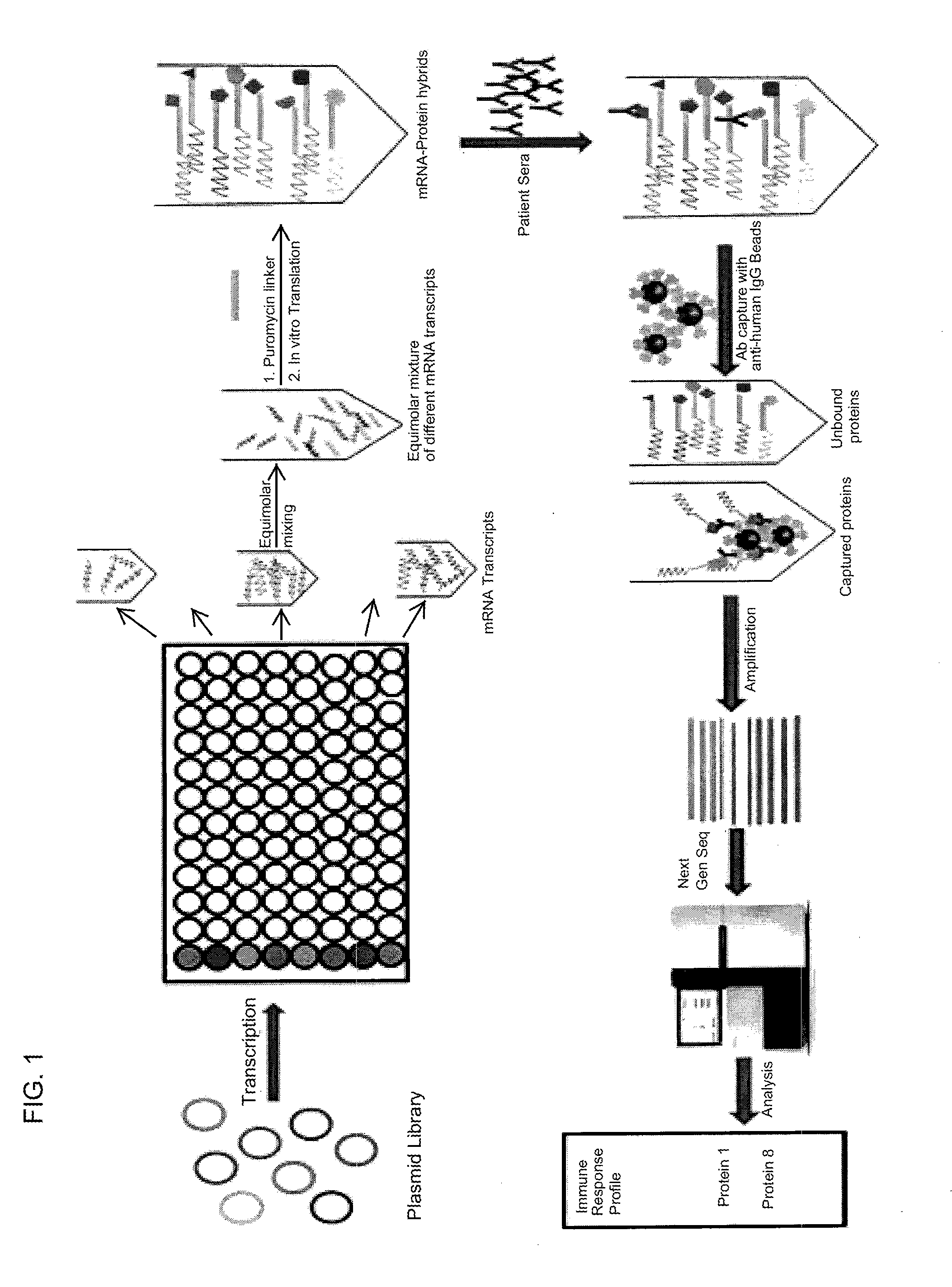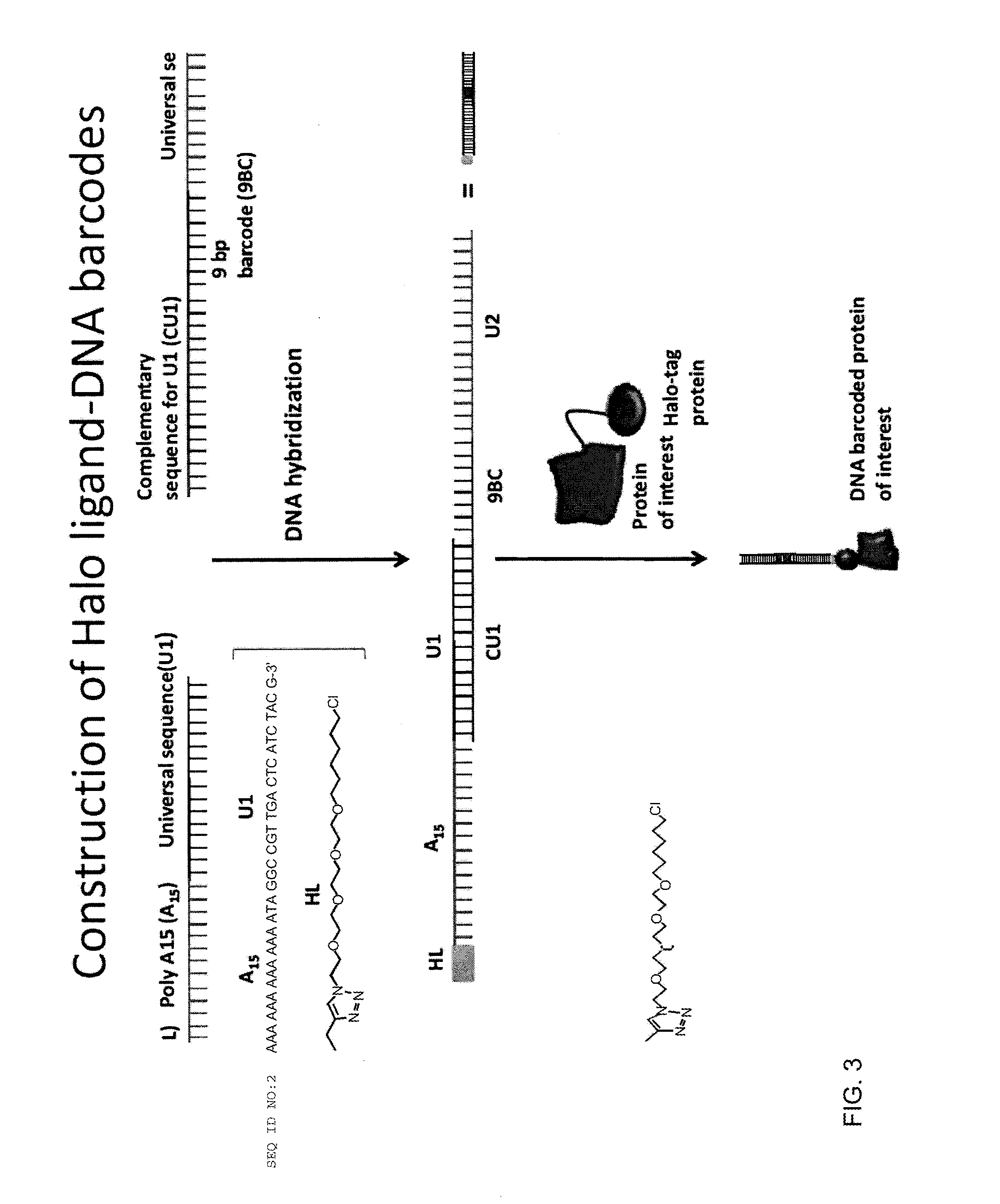Nucleic acid-tagged compositions and methods for multiplexed protein-protein interaction profiling
a technology of compositions and nucleic acids, applied in the field of nucleic acid-tagged compositions and methods for multiplexed proteinprotein interaction profiling, can solve the problem of identifying the many interacting target proteins of multiple protein actors in parallel, and achieve the effect of reducing the number of interacting proteins
- Summary
- Abstract
- Description
- Claims
- Application Information
AI Technical Summary
Benefits of technology
Problems solved by technology
Method used
Image
Examples
example 1
Multiplexed Detection of Antigens Recognized by a Patient Serum Sample
Library Vector Design
[0092]Using the library collection at DNASU of nearly 12,000 human genes with verified full-length sequences, open reading frames (ORFs) are cloned into expression vectors that include the promoter site for T7 polymerase positioned to drive sense strand transcription of the genes. Optionally, affinity tags are included (e.g., FLAG, HA) in the same reading frame to enable the selection of the mRNA-protein fusions. These clones will be created in Gateway system backbone so that genes can be readily transferred into the vector system in frame and accurately.
Generation of mRNA by In Vitro Transcription
[0093]Each mRNA transcript for corresponding genes is transcribed independently in a well plate platform. The transcription reactions is performed as previously described 1. Briefly, each plasmid is incubated with rNTP, MgCl2, T7 polymerase and a suitable buffer at 37° C. for a period of 6-12 hours. ...
example 2
Use of DNA “Bar Code”-Linked Prey Polypeptide Targets Materials and Methods
Generation of Halotagged Fusion Proteins
[0102]n-Halo and c-Halo tagged p53, EBNA, FOS and FBG were expressed in human coupled in vitro protein expression system (Thermo scientific). Protein expression was analyzed by incubating the proteins with 4 μM of Halo tag fluorescent ligand (Promega) followed by 4-20% SDS-PAGE gel analysis (FIG. 4). Full length expression was observed for all proteins except for n-Halo tagged EBNA.
Barcode, Halo-Ligand Hybridization
[0103]Equimolar concentration of DNA conjugated Halo-ligand was mixed with four different DNA barcodes in separate wells in the presence of buffer (10 mM Tris-HCl, 50 mM NaCl, 10 mM MgCl2, 1 mM DTT, pH 7.8) and 25 mM dNTP. The mixture was heated to 95° C. for two minutes and cooled gradually to room temperature for one hour, followed by klenow extension with 0.5 unit of Exo−Klenow polymerase (New England Biolabs) for 30 min at 37° C. The hybridized Halo ligan...
PUM
 Login to View More
Login to View More Abstract
Description
Claims
Application Information
 Login to View More
Login to View More - R&D
- Intellectual Property
- Life Sciences
- Materials
- Tech Scout
- Unparalleled Data Quality
- Higher Quality Content
- 60% Fewer Hallucinations
Browse by: Latest US Patents, China's latest patents, Technical Efficacy Thesaurus, Application Domain, Technology Topic, Popular Technical Reports.
© 2025 PatSnap. All rights reserved.Legal|Privacy policy|Modern Slavery Act Transparency Statement|Sitemap|About US| Contact US: help@patsnap.com



